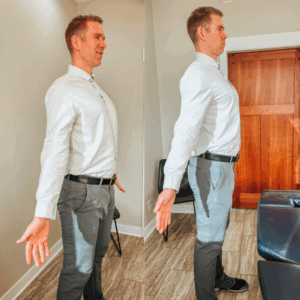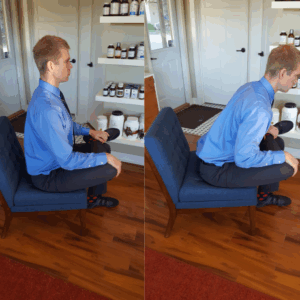How Posture Affects Energy, Pain, and Daily Life — And What You Can Do Today
Let’s be real: You don’t need a $400 office chair, crazy stretches, or another ibuprofen. What you do need is clarity, simplicity, and small daily actions that actually work.
At Rising Sun Chiropractic + Weight Loss, we want to empower you with tools you can use right now. In this post, we’re sharing the connection between posture and pain, energy loss, and tension — and a simple daily reset plan you can start today to feel better without more pills or pricey gadgets.
Posture Problems Are Energy Wasters
The truth is, poor posture habits often develop gradually — but their effects show up in ways that can feel anything but normal:
-
Headaches that start at the base of your skull or shoulders and move behind the eyes or forehead
-
Chronic tension that spreads from your neck into your shoulders, upper back, and even down your arms
-
Tingling or numbness in your hands or fingers
-
Tight chest muscles (pecs) that roll the shoulders forward, restricting breathing and movement
-
Hip flexor tightness from too much sitting, leading to a “stooped” appearance and lower back pain
-
Fatigue, even after a full night’s sleep, because your muscles are constantly overworking to hold you upright
This isn’t just about how you look sitting at a desk. These postural patterns can lead to joint restrictions that reduce mobility and put constant tension on nerves and muscles, triggering a cascade of problems — from pain and inflammation to poor circulation, shallow breathing, and yes, even low energy and mood.
Many people chalk these symptoms up to aging or stress — but they’re often signs of how your body is compensating for poor alignment.
Your Daily Posture Reset Plan
You don’t have to overhaul your life. You just need to give your body short, consistent breaks and a few well-chosen movements throughout the day. Start here:
1. Brugger’s Relief Position
Take 10 seconds every 40–50 minutes to reset your posture.
Sit at the edge of your chair, feet flat, palms open, shoulders gently rolled back, chin tucked. This helps your brain reconnect with ideal alignment.

2. Codman’s Arm Swings
Let your arm dangle and gently swing it in small circles.
This relieves tension in the shoulder joint and helps decompress tight rotator cuff muscles.
-
Start Position:
-
Stand next to a table or chair.
-
Lean forward slightly at the waist, supporting your non-injured arm on the table or chair.
-
Let your other arm (the affected or stiff shoulder) hang straight down toward the floor.
-
-
Movement:
-
Begin by gently swinging your arm in small circles (about the size of a dinner plate).
-
Do 10 clockwise circles, then 10 counterclockwise.
-
You can also swing your arm forward/backward and side to side in a relaxed, pendulum motion.
-
-
Key Tips:
-
Keep the movement gentle and passive — let gravity do the work.
-
Don’t use your shoulder muscles to swing; it should feel easy and pain-free.
-
Keep your back flat and avoid twisting your torso.
-
3. Nerve Flossing
Gently mobilize nerves in the arms or legs that may be irritated by tight muscles or joint pressure.
Start with gentle head tilts and arm motions (like threading a needle) to “floss” tension out.
Check out our post on flossing here to get a whole body routine you can do in less than 5 minutes.
4. Lower Body Reset
Figure 4 stretch (hips/piriformis)

-
Calf stretch (for ankle mobility + circulation)
-
How to Perform (Wall Method):
-
Stand facing a wall with both hands placed on it at shoulder height.
-
Step one leg back, keeping that heel pressed into the ground.
-
Bend the front knee while keeping the back leg straight.
-
Lean forward until you feel a stretch in the calf of your back leg.
-
Hold for 5-7 seconds and switch
-
Stiff-legged Deadlift stretch (hamstrings + back chain release
-
Stand tall with feet hip-width apart.
-
Slightly bend your knees (not locked), and hinge at your hips — not your back — keeping your spine straight.
-
Lower your torso toward the ground, letting your arms reach toward your shins or the floor.
-
Keep your back flat and feel a stretch in the hamstrings and lower back.
5. 3–5 Minute Walk Breaks
Set a timer. Get up and walk every hour.
This helps reset blood flow, joint movement, and clears tension built up from stillness.
6. Workstation Check
-
Feet flat, knees at 90°
-
Elbows slightly open
-
Screen at eye level
-
Keyboard and mouse just below elbow height to reduce wrist strain
Small changes, big results — especially when done consistently.
How We Can Help: Personalized Posture & Pain Solutions
If you’re dealing with tension headaches, chronic neck and back pain, or daily fatigue, a customized plan may be the missing piece. Our Free Posture Screenings can help identify the exact source of your discomfort and build a plan that fits your life.
Here’s how we help:
-
Gentle, specific chiropractic adjustments to restore motion and reduce joint tension
-
Laser therapy to target deep muscle and nerve inflammation
-
Targeted exercises and mobility work to support your weak areas and open tight ones
-
Nutrition and weight loss coaching to address inflammation and improve energy naturally
-
Step-by-step plans of care tailored to your goals, lifestyle, and schedule
Ready to Feel Better?
📍Located in St. Peter, MN, our office is here to help you stop surviving and start thriving again.
👉 Call 507-934-3333 or schedule your Free Posture Screening today at risingsunchiro.janeapp.com
Let us show you how good life can feel when your body is working with you, not against you.
